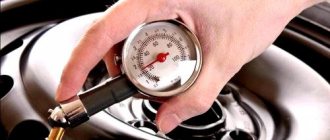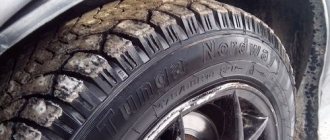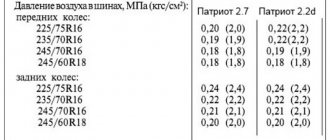What should be the tire pressure of Lada Vesta
| Tire size with load capacity and speed indexes* | Wheel size | pressure in tires front/rear, MPa (kgf/cm2) |
| rim width (inches) | partial load*** | |
| 185/65R15 88T, H 195/55R16 87, 91T, H | 5J, 5½J, 6J 5½J, 6J | 0,21/0,21 (2,1/2,1) |
3 lines•
How to optimally pump tires on a Lada Vesta - instructions
Many people know about the need to check tire pressure. If there is a discrepancy, the tires wear out faster, stability is lost, and the fact of inflated or flat tires affects handling and fuel consumption. Monitor the pressure, like any part of the car, tires need careful care and inspection. Familiarize yourself with the load capacity and speed indices and find out what parameters the tires of your car have. Let's figure out what the tire pressure should be on a Lada Vesta.
Wheels for sedan
AvtoVAZ installs several types of wheels on the Lada Vesta sedan. On budget cars, stamped wheels with a diameter of 15 inches are used. More expensive cars have light-alloy cast wheels R15 (model ANNA) or R16 (model PTALOMEY), manufactured by K&K (Russia).
The choice of a domestic manufacturer as a supplier of wheel rims is due to the high quality of the products and a guarantee for the entire service life.
The width of the rims set by the manufacturer is 6 inches (or J). During operation, it is allowed to use R15 disks with a width of 5J, 5½J, R16 disks - 5½J, 6½J. When replacing wheels with a different size, it is necessary to take into account the change in the vehicle's behavior on the road, the change in the degree of tire wear and the increase in fuel consumption with wider wheel options.
How often to measure to kill rubber
Please note that pressure may change due to changes in ambient temperature. Moreover, the process occurs equally in winter and summer. The main rule when checking is to measure it before driving, before the tires get hot. After a short trip, the wheels become very hot and the performance differs significantly from the real ones.
Measurements should be taken not only after tire wear has become noticeable. The manufacturer recommends checking the inflation when you feel that the car is behaving differently. For example, it began to throw to the sides, uncertainly when entering turns. In any operating book you will find information that a check must be carried out if temperature changes reach 10-15 degrees. As a rule, these are the spring/autumn seasons, be careful this is a time of temperature fluctuations.
What indicators depend on tire pressure
The following indicators depend on the air in the tires:
- Maneuverability;
- Controllability;
- Road grip;
- Fuel consumption;
- Cross-country ability - if you want to drive off-road, lower the tires.
Uninflated wheels can cause disc damage. Imagine you are driving on a road where the surface is not ideal. We drove through the pit, taking into account the weak pumping, the disk takes more load. For steel rims there is practically no problem, but “casting”, titanium rims, can not only bend, but crack. And the impact on the tire is no less.
It is enough just to look at the photo, as we see with different pumping, the surface of contact between the wheel and the road changes. This is why some areas wear out quickly, while others do not interact at all. Insufficient traction can cause an accident.
If you think pumping is not a problem, you are mistaken. Over-inflated tires are dangerous, increasing the risk of aquaplaning and similarly, the contact plane is smaller, causing uneven wear.
In conclusion, I would like to say, monitor the pressure, maintain it as required by the manufacturer. Pay attention to your own driving preferences. Fans of high-speed driving can deviate from the average by 0.1 bar. After all, at speed, the temperature rises, and accordingly the pressure, which is why an excess of the latter often leads to rupture of the rubber - be careful on the roads!
What kind of pressure should you keep in the tires on Vesta?
Tire pressure on Vesta is regulated both by the factory and by the driver independently, depending on the operation of the tires. What is the pressure of R15, taking into account the standard size 185/65 (tire) 88H and offset (rim width) 50 mm - 2.1 at partial and 2.2 atmospheres at full load. Taking into account the standard size 195/55 R16 91H with an offset of 50 ET - 2.1 and 2.2 “atmospheres”, at partial and full load, respectively.
For the winter
Lada Vesta tire pressure for winter recommended by the manufacturer depends on the size of the wheel and tires, it must exceed the norm + 0.1 MPa. In summer, for example, for R16 2.1 atmospheres, in winter 2.2 atmospheres are better due to frost.
For summer
The situation is similar with summer “sneakers”, but here we argue on the contrary, taking into account the increased temperature, it is better to reduce the pumping to -0.1 atmospheres. This difference will compensate for the thermal contraction or expansion of air in the wheel.
Winter tires
Buying winter tires for your car doesn't seem difficult. There is a huge selection of tires on sale for any operating conditions and financial capabilities.
Under these conditions, only general recommendations can be given.
- Depending on the location of use, city or rural, the tire tread should have different widths. In urban areas it should be narrower, in rural areas, vice versa.
- Choose a tread pattern based on the quality of road service - snowy or dry frozen asphalt.
- Winter is not for low-profile tires - they react to road irregularities and sharply reduce the smoothness of the ride.
- Installing tires from domestic manufacturers is much cheaper in cost, and the quality is not inferior to foreign analogues (Cordiant Winter Drive, Amtel Nordmaster, Amtel Nordmaster 2).
How many atmospheres to pump the wheels on the Lada Vesta Cross - instructions
The factory recommendation for Vesta Cross indicates from 2.2 to 2.4 “atmospheres”, this also depends on driving style. The size plays a role, considering that the manufacturer installs R17 wheels and size 205/50. Some people want a higher, wider tire, so they “play” with the inflation level as they want. But, you need to take into account all the features, what the load is, the diameter, the larger the diameter, the smaller the height. It is generally accepted that for the Cross version the average values range from 2.2 to 2.4 atmospheres.
Standard tire pressure monitoring system on Lada Vesta
At the moment, this system is available - it is installed on export versions of the Lada family: Vesta, XRay, Kalina, Granta. It’s hard to say when the option will appear on Lada models intended for Russia; the fact that the option is available is encouraging. Perhaps soon the “gadgets” will be available here too.
Taking into account the equipment of export vehicles, their “tidy” is also different, because this is where information from the sensors is sent. In general, the TPMS tire pressure monitoring system is represented by four built-in sensors in the wheel valves. TPMS sensors regularly measure and send data to the dashboard, informing the driver.
What pressure should be in Lada Vesta tires
Ride comfort indicators depend 70% on the size of the wheels and the correct inflation. This car is equipped with three types of wheels, and for each version the recommended tire pressure for the Lada Vesta is different.
Recommended pressure At.
An important parameter is the actual load of the machine. The above values are relevant for 4 adults in the car. If there is an additional load of about 100 kg inside the trunk. 0.1-0.2 units should be added to the nominal values.
The company insists on timely monitoring of correct tire inflation. In the absence of proper care, a decrease in actual indicators by more than 15% from the standard, such negative effects may occur.
- Accelerated wear of the tread.
- Reduced steering sensitivity.
- Increased braking distance.
- Increased fuel consumption.
- The likelihood of hydroplaning on wet asphalt increases.
To facilitate control, a TPMS system is installed on board the machine, which automatically measures tire inflation in real time. Thus, it is almost impossible to “mess up” the release wheel.
In what units is tire inflation measured?
The difference in the degree of tire inflation depends on the basic parameters of the car:
- Gross vehicle weight with or without loading. With a loaded car, the wheels are pushed through more than with an empty trunk and driver.
- Cylinder dimensions. Tire cavity capacity is of primary importance. For example, the pressure in winter tires R13 VAZ 2106 and R 16 on Vesta will differ by an average of 0.4 BAR.
- Speed index. At high speeds and driving on smooth asphalt, an improved free run is required. At the same time, for off-road modifications – this is not necessary.
In the CIS countries, the most common technical atmospheres are At, and pascals (kPa) or the metric system. However, in Europe and the USA, the units of measurement are their own (PSI, BAR). Due to the widespread use of imported rubber in Russia, the buyer needs to know exactly the ratio and compatibility of pressure gauge designations:
- 1 kg/cm²=98 kPa;
- 1 BAR= 100kPa;
- 1PSI= 6.9 kPa.
What tire pressure should I put on the Lada Vesta?
Marking on tires 350 kPs (51PSI). According to my calculations, the max is 0.35 MPa, but in those. the passport needs 0.21 MPa, how to keep the car all the time, as if it was deflated, pumping, as in the passport. Is it possible to increase MPa?
If I put tires with different indexes on one axle of a car, is it scary? Tires matador mp 47 hectorra 3 195 55 r16 91h and matador mp 47 hectorra 3 195 55 r16 87h.
XH MO T253 2618, pirelli ise zero tires.
I have a Lada vesta SW, station wagon, I need to choose winter tires, which ones will fit? Which winter tires suit the Lada Vesta station wagon best?
Why are all the wheels assembled on one side from the factory?
Vesta - 2.2 kg, maximum -2.3 kg. The higher the pressure, the harder the ride, the braking distance increases, and the skidding in turns increases. When the pressure drops, a notification will be displayed on the instrument panel.
Vesta tire pressure
What tire pressure should be on Vesta is specified in the manufacturer’s maintenance regulations, and is also determined by the driver regarding the operating conditions of the tires. The manual contains the following recommendations as indicated in the table.
| Tire size | Pressure under minimum load, atm | Pressure under maximum load, atm | ||
| Front axle | Rear axle | Front axle | Rear axle | |
| 195/65 R15 | 2.1 | 2.1 | 2.1 | 2.2 |
| 205/55 R16 | 2.1 | 2.1 | 2.1 | 2.2 |
| 205/50 R17 | 2.3 | 2.3 | 2.4 | 2.4 |
These data are given taking into account the load (when seating 3-4 adults). If there is additional cargo in the trunk, then the pressure in the Lada Vesta tires should be increased by 0.1-0.2 atm.
In winter, it is recommended to slightly increase the tire pressure of the Lada Vesta. For example, in summer, the standard pressure for R16 discs is 2.1 Atm, and during frosts it is better to set it to 2.2 Atm.
On the body of the Vesta (on the central pillar near the driver), depending on the configuration, you can find several options for plates that indicate the pressure parameters in the tires of the front and rear axles. Here are some basic options:
For the Lada Vesta Cross, the front and rear wheels with R15 and R16 tires should be 2.2 atm at normal load and 2.3 atm at maximum. If the tires are sized 205/50 R17, then 2.4 atmospheres is the maximum, but it is better not more than 2.3. These parameters are relevant for tires with indexes 89 H and 93 W.
If the pressure level decreases by at least 15%, this will lead to a negative impact on the tires:
- the tread part will wear out faster;
- braking distance will increase;
- the sensitivity of the steering wheel will decrease;
- fuel consumption will increase;
- On wet asphalt, aquaplaning can occur (partial or complete loss of traction between the tire and the road surface).
Answers (2)
The manufacturer recommends inflating tires with dimensions 185/65R15 and 195/55R16 to 2.1 bar, both front and rear. This is indicated in the instruction manual and on the plate.
If it suddenly seems that the wheels are too hard, then you can reduce it to 2.0 bar, but you should not reduce the pressure below.
It is also worth considering seasonality and checking pressure depending on the time of year.
For example, in summer, as the temperature rises, pressure increases, and in winter, it decreases. It is not for nothing that at tire shops, before winter re-shoeing, when it is not yet completely cold, but the temperature is about to drop, tires are inflated slightly above the recommended values.
Check pressure when temperature changes and more.
Many people know how important it is to periodically check the pressure in your car tires. If the pressure does not meet the manufacturer's recommendations, the tires will wear out faster, stability and controllability on the road will deteriorate, and fuel consumption will also increase.
Do you know what the pressure should be in the Vesta wheels?
In the vehicle operating instructions, the manufacturer indicated the following recommendations:
| Tire size with load capacity and speed indexes* | Wheel size | Air pressure in tires front/rear, MPa (kgf/cm2) | ||
| rim width (inches) | rim offset (ET)**, mm | partial load*** | full load**** | |
| Installed by the manufacturer | ||||
| 185/65R15 88H 195/55R16 91H | 6J | 50 | 0,21/0,21 (2,1/2,1) | 0,2/0,22 (2,1/2,1) |
| Allowed to be installed during operation | ||||
| 185/65R15 88T, H 195/55R16 87, 91T, H | 5J, 5½J, 6J 5½J, 6J | 50 | 0,21/0,21 (2,1/2,1) | 0,21/0,21 (2,1/2,1) |
* Speed indices: T – up to 190 km/h, H – up to 210 km/h. Load capacity indices: 88–560 kg; 91–615 kg. **Rim offset (ET) is the distance from the mating plane of the disc to the middle of the rim. *** Partial load – no more than 3 adults in the car without cargo in the trunk. **** Full load – more than 3 adults or 3 adults and a load of 50 kg in the trunk.
How much to pump the wheels can also be found out from the plate, which is located on the central pillar of the body on the driver's side (visible when the door is open).
If you notice that the tire pressure is dropping, first check the serviceability of the valve spool. If it does not allow air to pass through, then the tire is most likely damaged; contact a tire repair shop.
Important! The air pressure in the tire is not constant. When the ambient temperature rises, the tire pressure increases, and when the ambient temperature decreases, it drops.
You should check the pressure in Vesta tires when the temperature difference is 10-15 o C. Also, the pressure in the tire increases while the car is moving, so checking it immediately after the trip is incorrect. Wait until the tire temperature is equal to the ambient temperature.
Tire pressure Lada Vesta
IMPORTANT! The pressure must be measured on a cold tire (the car must be at rest for at least 2 hours before measurement). IMPORTANT! All pressure values indicated in the table are given for the recommended tire sizes of your Lada Vesta.
Lada (VAZ) Vesta
| Model and modification | Recommended tire size | Regular download | Full load | ||
| Front | Rear | Front | Rear | ||
| Vesta | 185/65 R15 88H | 2.1 | 2.1 | 2.2 | 2.2 |
| 195/55 R16 91H | 2.1 | 2.1 | 2.2 | 2.2 | |
| Vesta Cross | 205/50 R17 89V | 2.2 | 2.2 | 2.3 | 2.3 |
| 205/50 R17 93W | 2.2 | 2.2 | 2.3 | 2.3 | |
Designations in the table : SSR - RUNFLAT tires, allowing you to continue driving after loss of air pressure in the tire; VA - standard size of tires installed on the front axle of the car; HA - standard size of tires installed on the rear axle of the car; XL is a tire with increased load capacity.
Source











